ویلایی از دو دیار
پژمان طیبی، شیوا نجفی
موقعیت: روستای چپرپرد، بندر انزلی، ایران
تاریخ: ۱۴۰۳
مساحت: ۱۸۰ مترمربع
وضعیت: ساختهشده
کارفرما: خانواده سنجابی
سازه: مسعود برادران
تاسیسات مکانیکی: آقای سنجابی، جمشید رضانژاد
تاسیسات الکتریکی: علی جعفرزاده
اجرا: سامان شهیدی
تیم اجرا: احسان شهیدی، امیر محمدی، محمد حیدری، علی شهبازی
عکس: پژمان طیبی
در ایران مملو از ساختمانهای کلیشهای، رومی و یا نهایتا مدرن و مینیمال، آیا میتوان حس و حالی از ایران را در یک ساختمان داشت؟ و حسی از گیلان …؟ موقعیت این پروژه در گیلان بود، اما کارفرمای آن خواستار ویلایی مدرن و مینیمال بودند؛ ساختمانی با هویتی بینالمللی و امروزی و طرحی کلیشهای که نه تنها رنگ و بویی از منطقه گیلان، بلکه حتی از بقیه ایران نیز نداشته باشد. اما ما بر خلاف کارفرما، میخواستیم که ساختمان حس و حالی از گیلان و ایران داشته باشد. کارفرمای پروژه، خانوادهای بودند ساکن تهران و بزرگشده در خانههایی با شیشههای رنگی. قصد داشتیم ویلایی بسازیم که رنگ و بویی از کودکی کارفرما داشته و حس و حال خانههای سنتی مرکز ایران را روایت کند، همانهایی که پنجرههای ارسی دارند. در عین حال، میخواستیم وقتی ساختمان در کنار همسایهها دیده میشود، حس و حال خانههای شمال ایران و گیلان را نیز داشته باشد و با آن غریبه نباشد.
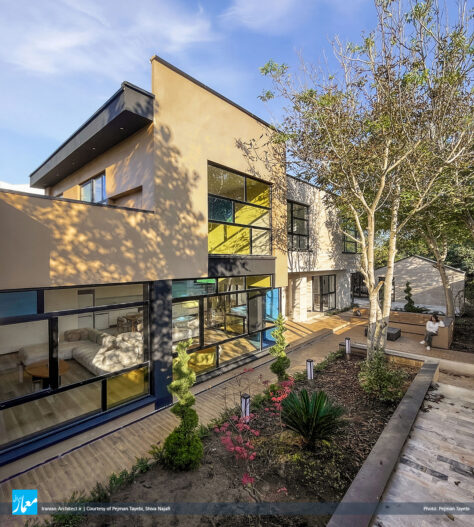
در زمین پروژه، چند درخت گردوی قدیمی وجود داشت که نمیخواستیم آنها را قطع کنیم. به همین دلیل، جهتگیری و حجم کلی ساختمان را بر مبنای این درختان تنظیم کردیم. کانسپت پروژه، بر اساس تضاد بین فضای نیمهعمومی (نشیمن و …) و نیمهخصوصی (اتاقها و …) شکل گرفت. هر کدام از این دو بخش، فرم و حجمی متفاوت داشتند. بخش اول، با سقف شیبدارش، فرم روتین یک خانه شمال کشور را تداعی میکرد، بازتابی از گیلان؛ بستری که پروژه در آن قرار داشت. حجمهایی به فرم کلبههای شیبدار که کنار هم و روی هم قرار دادیم. اما فضای نیمهعمومی با متریالی به رنگ کاهگل و شیشههای رنگی، بازتابی نمادین بود از خانههای ایرانی، خانههایی که نه تنها در اصفهان و کاشان بلکه در جایجای ایران وجود دارند. رنگها و بافتهایی که خاطرات ایران را در یاد زنده نگه میدارند.
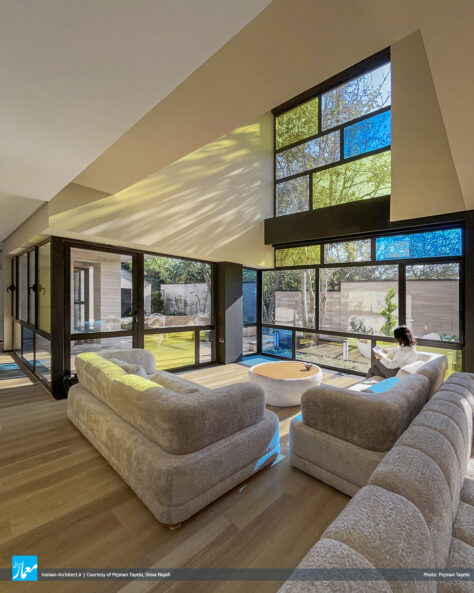
در نهایت، پروژه از همنشینی فرم خانه شیبدار شمال کشور و خانه سنتی ایرانی با اُرسیها و شیشههای رنگیشان تشکیل شد. کاربری که از بیرون به داخل وارد میشود، در ابتدا کلبهها را میبیند و سپس در سکانس بعدی، حس و حالی از ارسی و خانههای ایرانی و پنجرههای ارسی را تجربه میکند. در نهایت، این تضاد و همنشینی، نه تنها در فرم بیرونی، بلکه در طراحی داخلی پروژه نیز وارد شد تا همه ارکان پروژه در کنار هم، تشکیل یک کل واحد و منسجم را بدهند.
Two Regions, A Villa
Pejman Tayebi, Shiva Najafi
Location: Chaparpard Village, Bandar-e Anzali, Iran
Date: 2024
Area: 180 sqm
Status: Completed
Client: Mr. & Mrs. Sanjabi
Structure: Masoud Baradaran
Mechanical Engineering: Mr. Sanjabi, Jamshid Rezanejad
Electrical Engineering: Ali Jafarzadeh
Construction: Saman Shahidi
Construction Team: Ehsan Shahidi, Amir Mohammadi, Mohammad Heidari, Ali Shahbazi
Photo: Pejman Tayebi
Iranian architecture has always been regional throughout history, featuring various historical patterns and ancient traditions. Based on this principle, we sought for each climate in different geographical regions to reflect its own culture and identities in its architecture, art, and way of life.
The project is located in the northern regions of Iran, and the client is a family from the central areas of Iran, whose request was the design of a modern and contemporary house. We began the design process based on the client’s lived experience, the architectural pattern of their hometown, as well as the context in which the project was located.
Considering the presence of several old trees on the project site, we adjusted the orientation and overall volume of the building based on the trees to avoid cutting them down. The concept of the project was based on the contrast between semi-public spaces (such as the living area, etc.) and semi-private spaces (such as the rooms, etc.), each with its own distinct form. The first component of the volumes consists of the forms of sloped-roof cottages that are placed next to and on top of each other, symbolizing a house in the northern regions of the country. The semi-public space, featuring materials in the color of adobe and colored glass, reflects a symbolic representation of the traditional houses of Iran, particularly in the central regions. The user entering from the outside first sees the cottages and then, in the next sequence, experiences a sense of Iranian houses and the traditional “Orsi” (Persian stained glass windows).
In conclusion, the project consists of the coexistence of the cottage form with a sloped roof found in the northern regions of the country and traditional Iranian houses with “Orsi.” This contrast is present not only in the exterior form but also in the interior design, so that all elements of the project come together to create a cohesive and unified whole.

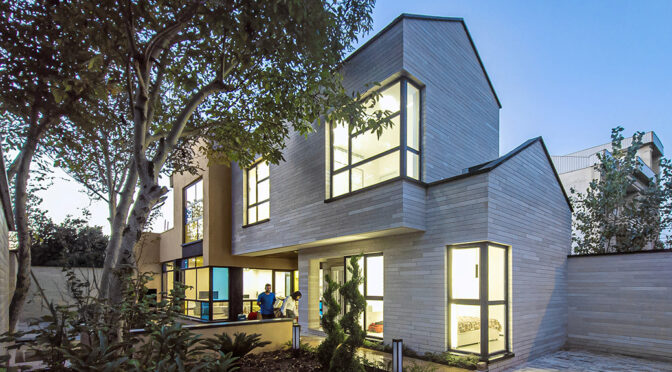
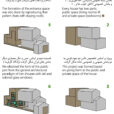
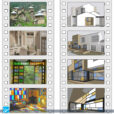
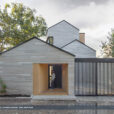
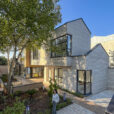
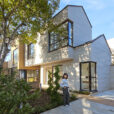
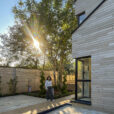
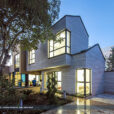
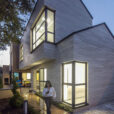
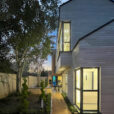
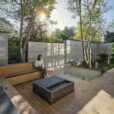
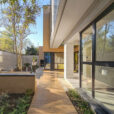
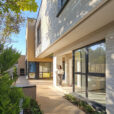
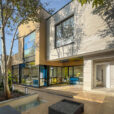
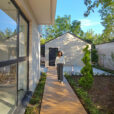
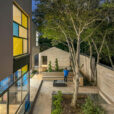
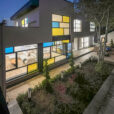
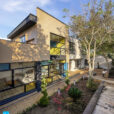
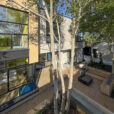
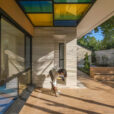
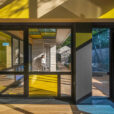
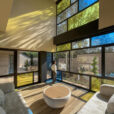
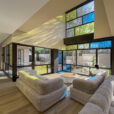
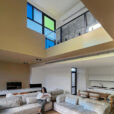
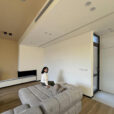
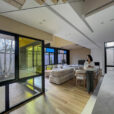
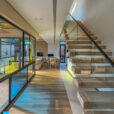
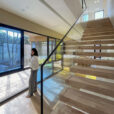
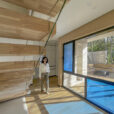
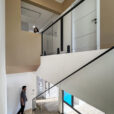
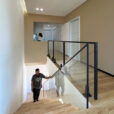
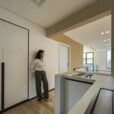
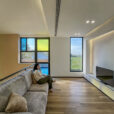
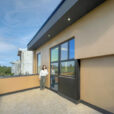
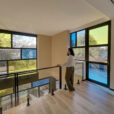
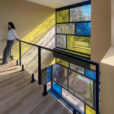
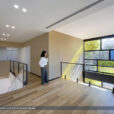
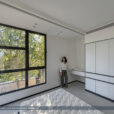
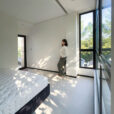
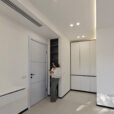
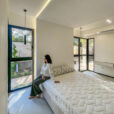
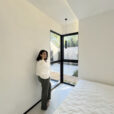
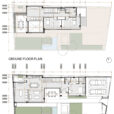
درود و احترام
نقدی بر کانسپت و طرح معماری ویلا
پیش از هر چیز، پیشنهاد میشود خواننده محترم ابتدا توضیحات طراح پروژه را با دقت مطالعه فرماید تا درک روشنی از پیشفرضهای فکری وی حاصل گردد.
یکی از پرسشهای بنیادین در طراحی معماری آن است که آیا تنش ذهنی و عدم تطابق میان ذهنیت کارفرما و طراح میتواند منجر به شکلگیری یک کانسپت منسجم شود؟ بهصورت اصولی، پاسخ منفی است؛ چراکه کانسپت معماری باید از یکپارچگی ایده و انسجام عملکردی برخوردار باشد. با این حال، در این پروژه، نتیجهی چنین تضادهایی به خلق فرمی انجامیده که حاصل ترکیب دو ذهنیت ناهمگون از دو بستر زمانی و فضایی متفاوت است.
اما مسئلهای که در این میان مغفول مانده، عدم شکلگیری “وحدت طراحی” و “فرکتال مفهومی” در کلیت معماری است. از نگاه نگارنده، چنین ترکیبی زمانی قابل قبول است که به خلق یک “عنصر سوم” یا کیفیت فضایی جدید بینجامد؛ یعنی ترکیبی نوآورانه که از تنش این دو ذهنیت زاده شود و به زبان معماری تازهای منتهی گردد. اما در این طرح، به نظر میرسد بیش از آنکه دغدغه معماری و فضا مدنظر باشد، سلیقهی کارفرما و معمار بهصورت جداگانه ارضا شده و در نتیجه، سبد معماری پروژه، تهی از ایدهای عمیق باقی مانده است.
تحلیل عملکردی فضاها
ورودی و ارتباط با فضاهای خصوصی:
استقرار اتاقهای خواب و فضای خصوصی در مجاورت درب ورودی، منجر به حذف نظارت و کنترل بصری ساکنین بر فضای ورود میشود. این چیدمان عملکردی نهتنها از منظر امنیتی و رفتوآمد مناسب نیست، بلکه از دیدگاه نظم فضایی نیز محل تأمل است.
راهروها و اتلاف فضا:
مسیر مستقیم ۶ متری پس از ورودی و همچنین راهروی ۱۰ متری در طبقه فوقانی، منجر به اتلاف حدود ۳۰٪ از زیربنای پروژه شدهاند. چنین سطحی از اشغال بدون تعریف فضایی خاص، حاکی از کمبود برنامهریزی عملکردی است و طراحی مؤثر جایگزینی میتوانست اجرا شود.
سازماندهی فضاهای عمومی:
اتصال نشیمن، پذیرایی و آشپزخانه به شکلی انجام شده که هیچکدام هویت فضایی مستقل ندارند و صرفاً با چیدمان مبلمان سعی در تعریف قلمرو دارند؛ امری که در طراحی اصیل و فکرشده معماری جایگاهی ندارد. معماری با معنا، باید بدون نیاز به تزئینات و وسایل جانبی، شخصیت خود را حفظ کند.
جانمایی آشپزخانه:
قرار گرفتن آشپزخانه در دورترین نقطه نسبت به ورودی، آن هم بدون دید مناسب به حیاط و فضای بیرونی، باعث کاهش کارایی این فضای مهم شده است. درحالیکه آشپزخانه میتوانست هسته مرکزی پروژه باشد و عملکرد درونی و بیرونی خانه را پیوند دهد، در حاشیهای نامناسب گرفتار شده است و این تصمیم طراحی، آسایش کاربران را بهطور قابل توجهی تحت تأثیر قرار داده است.
در مجموع، پروژه با وجود داشتن پتانسیلهایی در خلق فضای معماری، درگیر تضادهای حلنشدهی ذهنی میان طراح و کارفرماست. امید است بازنگری در منطق سازماندهی فضایی و تقویت انسجام مفهومی، بتواند به ارتقاء سطح کیفی پروژه منجر شود.
با احترام
مهندس علیرضا یکتا
کارشناس ارشد معماری